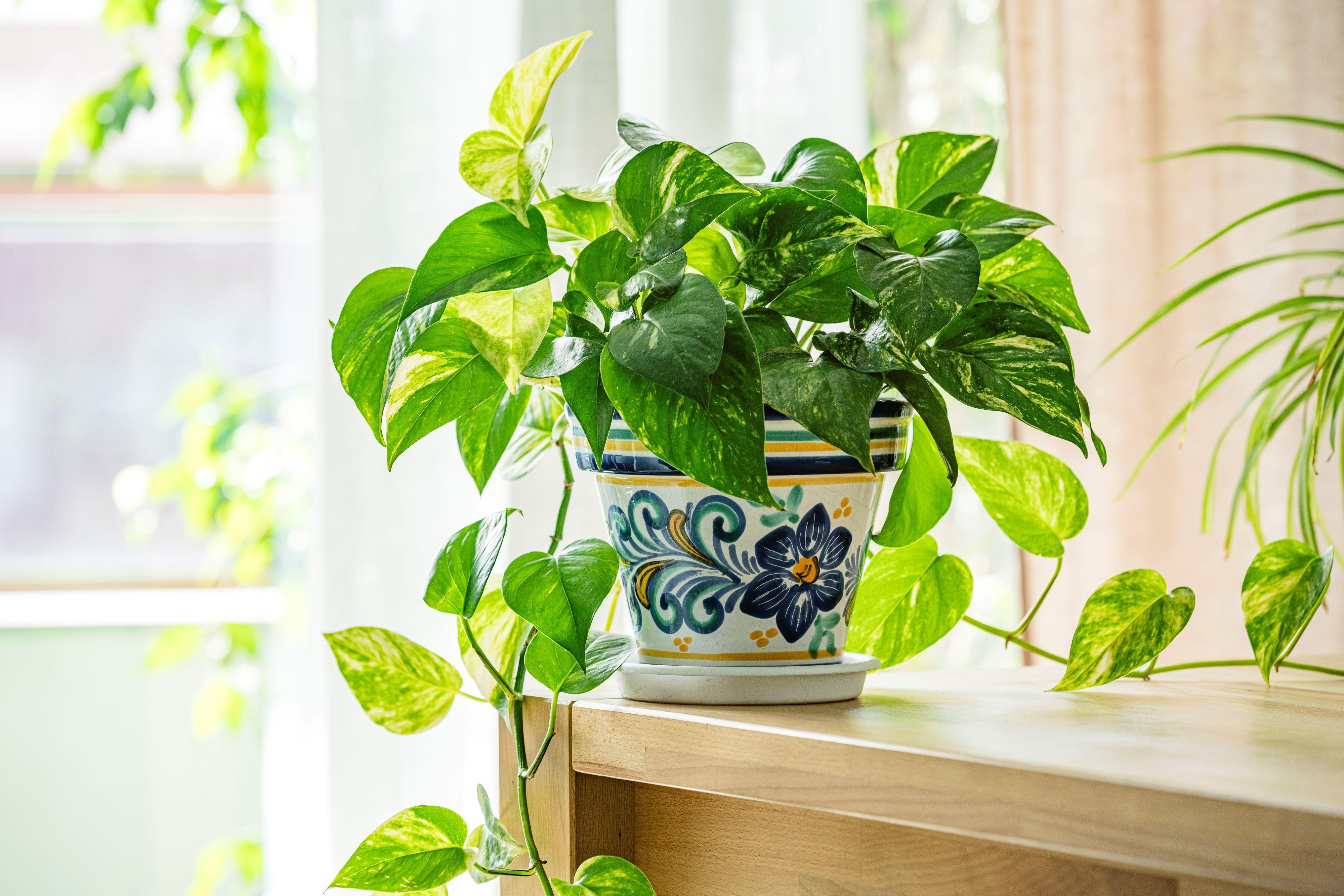Variegated varieties of pothos may naturally have some golden or yellow patterns on the leaves, which is nothing to worry about. But if your pothos leaves are yellowing when they shouldn't be, it’s likely a sign that something isn’t right and needs to be addressed. Here's how to figure out the cause, along with tips for correcting and preventing the problem.
1. Too Much Sun
Pothos are tropical understory plants adapted to thrive in the dappled light that filters through the upper canopy. In our homes, that equates to bright but indirect light (even though they’ll survive practically forever in poor light). Placing pothos in direct sunlight can overload them, causing the leaves to turn yellow.
As the seasons change, it’s common for a spot in the house that wasn’t getting much sun in winter to be in direct sunshine for several hours a day in summer. So if your pothos is now baking in the sun, simply moving it to a less sunny spot will allow your plant to recover.
2. Lack of Nutrients
Several nutrient deficiencies cause plant leaves to yellow. One of the most common is a lack of nitrogen, which causes older leaves to turn yellow first. Adding some liquid houseplant fertilizer can soon remedy this situation.
But if you have been regularly fertilizing your plant, you may have a pH problem that's making nutrients unavailable to roots. While not commonly an issue in potting soil, the pH can change over time due to the buildup of fertilizers and other chemicals. If the pH gets too acidic, nitrogen uptake is greatly reduced, leading to a deficiency in the plant, even if there's plenty of nitrogen in the potting soil.
Check the pH with a quick home test kit if you like, but the best thing to do is repot the plant in fresh potting soil. If your soil doesn't already include some nutrients, mix in some slow release fertilizer according to package directions.
3. Pest Problems
Yellowing leaves can be caused by insect damage. Pothos grown as houseplants can be infested with spider mites or whiteflies, which can cause yellowing or pale leaves. Damage to the unhealthy leaves and bugs caught on a yellow sticky card trap are telltale signs.
For indoor plants, insecticidal soaps and neem oil products can be used. However, neem oil is not safe for pollinators and should be used outdoors only with great care. When applying, follow the directions on the label.
4. Overwatering
Overwatering can cause yellowing or black leaves, along with root rot. The easiest way to determine root rot problems is to gently lift the entire plant, roots and all, free from its container, and inspect the roots. On a healthy plant, the roots will be creamy white or tan colored, sturdy, and flexible. If they look mushy, dark brown, black, or slimy, your pothos has root rot.
You may be able to save the plant by trimming off the rotted roots, rinsing the entire root ball, and repotting it in fresh potting soil in a new or sanitized container. Alternatively, you can take cuttings from the best-looking stems and start new plants.
Related
5. Underwatering
Underwatering is also a common cause of yellowing leaves, and it's easy to check for. While underwatered pothos commonly wilts first, you may also notice some yellowing of leaves.
Use your finger to check the soil moisture an inch or two down. If the soil is dry, water thoroughly, ensuring the pot’s drainage holes are in working order. Check the soil moisture weekly or more often, allowing the soil to dry slightly but never become totally dry before watering well again.
6. Soil Toxicity
If you’ve noticed white crystalline deposits on the surface of the potting soil, this could indicate less than ideal conditions for the roots. Over-fertilization, buildup of impurities from the water source, and too much acidity in potting soil all can stress your pothos and eventually lead to yellowing leaves.
If the potting soil is relatively new, you can try to flush out the harmful deposits. Take the plant to the sink and run room-temperature tap water slowly into the potting soil, letting it run out the bottom. Keep gently running water through the soil until you’ve run at least three times the volume of the pot. Then let the pot finish draining completely in the sink.
The water flow will leach soluble chemicals out of the potting mix and send them down the drain. Potting soil in houseplants should be flushed about every six months if you notice signs of salt buildup. In severe cases, remove the plant, rinse the old soil off the roots, and repot it in fresh soil.
7. Natural Shedding of Older Leaves
Like many other plants, pothos will naturally self-prune older, lower-performing leaves. When this happens, they start to yellow and eventually drop off. Over time this can result in long stretches of bare stems closer to the pot as the plant concentrates on developing new growth on the tips of the vines. Prune the vines back to promote fresh growth. The vines can be cut back within a few inches of the soil if needed, but only cut one or two at a time so you don’t shock the plant.



